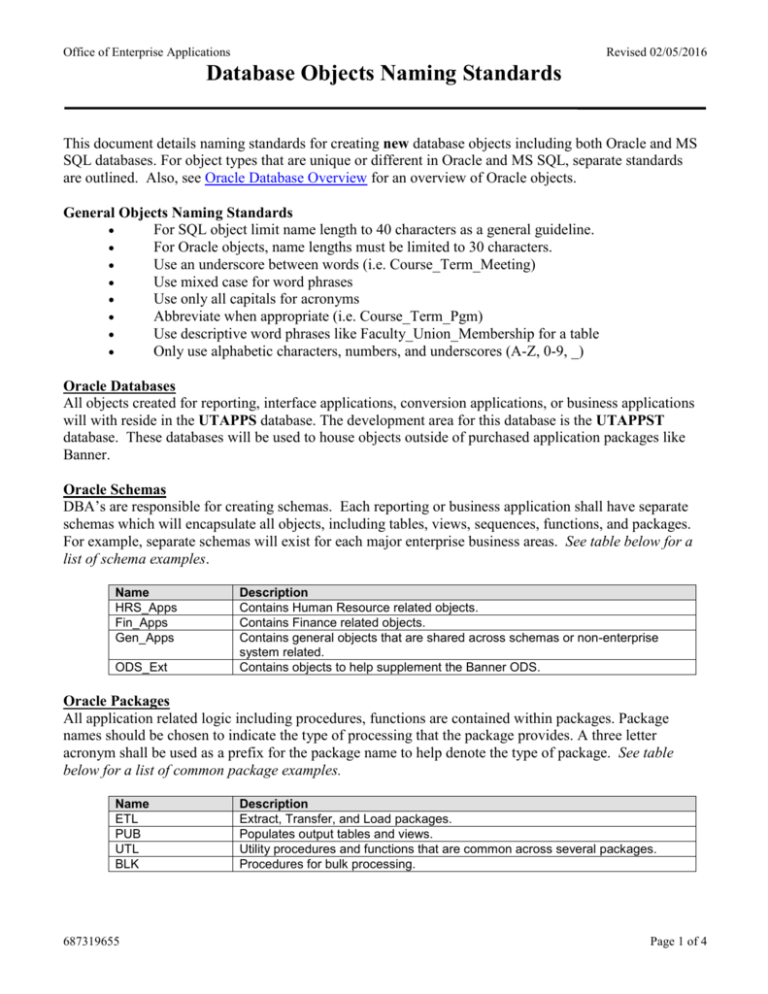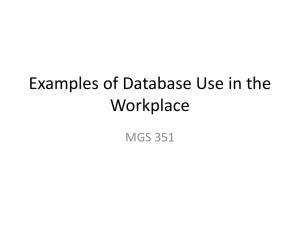Database Object Naming Standards
advertisement

Office of Enterprise Applications Revised 02/05/2016 Database Objects Naming Standards This document details naming standards for creating new database objects including both Oracle and MS SQL databases. For object types that are unique or different in Oracle and MS SQL, separate standards are outlined. Also, see Oracle Database Overview for an overview of Oracle objects. General Objects Naming Standards For SQL object limit name length to 40 characters as a general guideline. For Oracle objects, name lengths must be limited to 30 characters. Use an underscore between words (i.e. Course_Term_Meeting) Use mixed case for word phrases Use only all capitals for acronyms Abbreviate when appropriate (i.e. Course_Term_Pgm) Use descriptive word phrases like Faculty_Union_Membership for a table Only use alphabetic characters, numbers, and underscores (A-Z, 0-9, _) Oracle Databases All objects created for reporting, interface applications, conversion applications, or business applications will with reside in the UTAPPS database. The development area for this database is the UTAPPST database. These databases will be used to house objects outside of purchased application packages like Banner. Oracle Schemas DBA’s are responsible for creating schemas. Each reporting or business application shall have separate schemas which will encapsulate all objects, including tables, views, sequences, functions, and packages. For example, separate schemas will exist for each major enterprise business areas. See table below for a list of schema examples. Name HRS_Apps Fin_Apps Gen_Apps ODS_Ext Description Contains Human Resource related objects. Contains Finance related objects. Contains general objects that are shared across schemas or non-enterprise system related. Contains objects to help supplement the Banner ODS. Oracle Packages All application related logic including procedures, functions are contained within packages. Package names should be chosen to indicate the type of processing that the package provides. A three letter acronym shall be used as a prefix for the package name to help denote the type of package. See table below for a list of common package examples. Name ETL PUB UTL BLK 687319655 Description Extract, Transfer, and Load packages. Populates output tables and views. Utility procedures and functions that are common across several packages. Procedures for bulk processing. Page 1 of 4 Office of Enterprise Applications Revised 02/05/2016 Database Objects Naming Standards SQL Databases DBA’s are responsible for creating databases. All objects created for reporting, interface applications, conversion applications, or business applications will with reside in separate databases from data extracted from the SCT Plus legacy systems or from purchased applications. For a list of the SQL productions databases see SQL Production Databases. Databases for SCT Plus extracted data are named with a three letter acronym. See table below for a list of examples. Name ADM SIS HRS Description Contains Admissions related data extracted from the Student SCT Plus system. Contains Student related data extracted from the Student SCT Plus system. Contains Human Resource (HR) and Finance related data extracted from both the HR and Finance SCT Plus systems. Databases objects created for reporting, interface applications, conversion applications, or business applications will with reside in databases with an appropriate three letter acronym followed with “_Apps” at the end of the name. See table below for a list of examples. Name ADM_Apps SIS_Apps HRS_Apps Description Contains Admissions related objects not extracted from the Student SCT Plus system. Contains Student related objects not extracted from the Student SCT Plus system. Contains Human Resource (HR) related objects not extracted from the Human Resource SCT Plus system. SQL User Stored Procedures (USP) Use a “usp” prefix in the name Place an application acronym after the “usp” prefix when applicable to denote stored procedures for applications like the Executive Contact Management System or Course Catalog applications Use a verb in the first word phrase to help describe the work being performed USP naming architecture: usp_[<application acronym>_] <descriptive name> Examples include: usp_ECMS_Get_Entity_Types usp_ECMS_Search_Faculty usp_ECMS_Create_Grant_Object_Codes 687319655 Page 2 of 4 Office of Enterprise Applications Revised 02/05/2016 Database Objects Naming Standards SQL Data Transformation Services (DTS) Packages Since DTS packages are not contained within a database, use a system or application acronym prefix in the name Use a verb in the first word phrase to help describe the work being performed DTS naming architecture: <application or system acronym>_<descriptive name> Examples include: BRS_Import_Deregistration_Data SIS_Extract_Data_Warehouse_Files CC_Set_Course_Desc_Current_Record User Defined Functions (UDF) Use a “udf” prefix in the name Place an application acronym after the “udf” prefix when applicable to denote functions for applications like the Grants Accouting or Transcation Integration System applications Use a verb in the first word phrase to help describe the work being performed UDF naming architecture: udf_[<application acronym>_] <descriptive name> Examples include: udf_GAS_Format_Phone_Num udf_TIS_Parse_Name Tables For tables in an application database, use an uppercase acronym name prefix to denote the specific application Avoid using reserved keyword identifiers like Codes, Dim, Fact, and Sum as table name word phrases (see Standards for Specific Table Types below) Table naming architecture: [<application acronym>_] <descriptive name> Examples include: EC_Executive_Contacts (EC denotes the Executive Contact application) CC_Published_Course_Catalog (CC denotes the Course Catalog application) Course_Term_Meeting Oracle Tables Use an underscore and a three digit number at the end of the table name to denote a version number. Each time a table is revised, the version number should be incremented by one. For example, the first version of a table would have “_001” at the end of the table name. Table naming architecture: [<application acronym>_] <descriptive name>_nnn The synonym name will not contain a suffix to denote a version number. 687319655 Page 3 of 4 Office of Enterprise Applications Revised 02/05/2016 Database Objects Naming Standards Standards for Specific Table Types Use special word identifiers at the end of table names to help identify specific table types See table below for a list of special table types Table Types Lookup (decode) Identifier _Codes Dimension _Dim Fact Summary _Fact _Sum Cross reference _Xref Banner modified views for security reasons _UT Special Table naming architecture: [<application acronym>_] <descriptive name>_[identifier] Examples include: College_Codes EC_Entity_Codes Student_Course_Term_Fact Term_Dim Course_Term_Sum Views Use Table Standards with “_View” at the end of the name Table View naming architecture: [<application acronym>_] <descriptive name>_View Examples include: Student_Address_Local_View CC_Published_Course_Catalog_Term_View 687319655 Page 4 of 4






